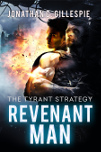The Future of Weaponry is Our Past
November 1, 2012 in General Topics
A lively discussion broke out on the Kindleboards recently about weaponry in various authors’ science fiction world-building. The topic produced great food for thought, and also gave me a chance to reiterate my belief that simple, reliable weapons aren’t going anywhere.
Yes, The Tyrant Strategy: Revenant Man spends some time on the great threat still menacing Zone 6 (roughly compromising the Rockies), left behind by the Akita Wars, in the form of that tyrant’s autonomous hunter-killer drones. Drones will, sadly, become more prevalent domestically and internationally in the coming years. This is despite the well-founded civil rights concerns.
 But for the average belligerent on the ground, simple firearms will more often than not remain the order of the day, just as they do in my novel. Forces outfitted by cash-flush nations bring highly advanced gear to conflicts, but professional soldiers are outnumbered, globally, by conscripts, civilian militants, and partisans. Think about the weapons loadout of the Viet Cong in the Vietnam War, for example. The majority of their infantry’s firepower consisted of designs dating back decades, sometimes all the way back to World War I.
But for the average belligerent on the ground, simple firearms will more often than not remain the order of the day, just as they do in my novel. Forces outfitted by cash-flush nations bring highly advanced gear to conflicts, but professional soldiers are outnumbered, globally, by conscripts, civilian militants, and partisans. Think about the weapons loadout of the Viet Cong in the Vietnam War, for example. The majority of their infantry’s firepower consisted of designs dating back decades, sometimes all the way back to World War I.
The communist guerrilla forces needed rugged weaponry, and they didn’t care that it was old gear. A bullet is a bullet is a bullet. The emphasis was on making sure that when the trigger was squeezed, the firearm would do its job. Everything else was secondary. Rifles, pistols and SMG’s had often traded owners dozens of times, and/or passed through multiple armies.
 This same pattern of using “heirloom weaponry” has been a part of military history since the subject has existed. What’s simple, reliable and easily field-serviceable will generally find wider use than a more-advanced counterpart.
This same pattern of using “heirloom weaponry” has been a part of military history since the subject has existed. What’s simple, reliable and easily field-serviceable will generally find wider use than a more-advanced counterpart.
The most exotic weapons tech in Revenant Man are “field” weapons. Field technology relies on using a concussive force to punch through the air, sort of like a noise cannon taken to its extreme evolution. The blast is so strong it produces a visible light effect from superheating the molecules in its path.
 But–here’s the key–this sort of tech is cantankerous, and requires loads more maintenance. So your average “radical” (in Serpican terminology), supply raider, or civilian continues to use bullet-loading weapons. These guns are trusted equipment, often handed down through generations. They wind up being more significant in the first novel than energy weapons. As a literary device, field tech is primarily used to show just how advanced the Serpian Police is compared to their Earthside adversaries.
But–here’s the key–this sort of tech is cantankerous, and requires loads more maintenance. So your average “radical” (in Serpican terminology), supply raider, or civilian continues to use bullet-loading weapons. These guns are trusted equipment, often handed down through generations. They wind up being more significant in the first novel than energy weapons. As a literary device, field tech is primarily used to show just how advanced the Serpian Police is compared to their Earthside adversaries.
There’s a second argument, as well–significant infrastructure is necessary to produce an object like a field rifle, it’s fair to say the only governing bodies capable would be vast, wealthy nations. Since Revenant Man‘s Earth of 2142 has seen so much revolution and decentralizing of the planet’s former superpowers (sometimes down to pockets of civilization as small as city-states), then it wouldn’t have made sense to have almost every soldier running around with high-end tech.
Science fiction that does that baffles me. Even Star Wars draws some of my criticism for that miscalculation. Widely-distributed, cool tech makes more sense in an environment surging with globalism, not in some back backwater area. In a dystopian landscape, especially, sophistication gives way to ruggedness. Whether the result is metal-on-metal rifles, or even more basic weapons–like bows and arrows–rest assured: the people occupying the world just want the tech to work.
Stay tuned.

Recent Discussion